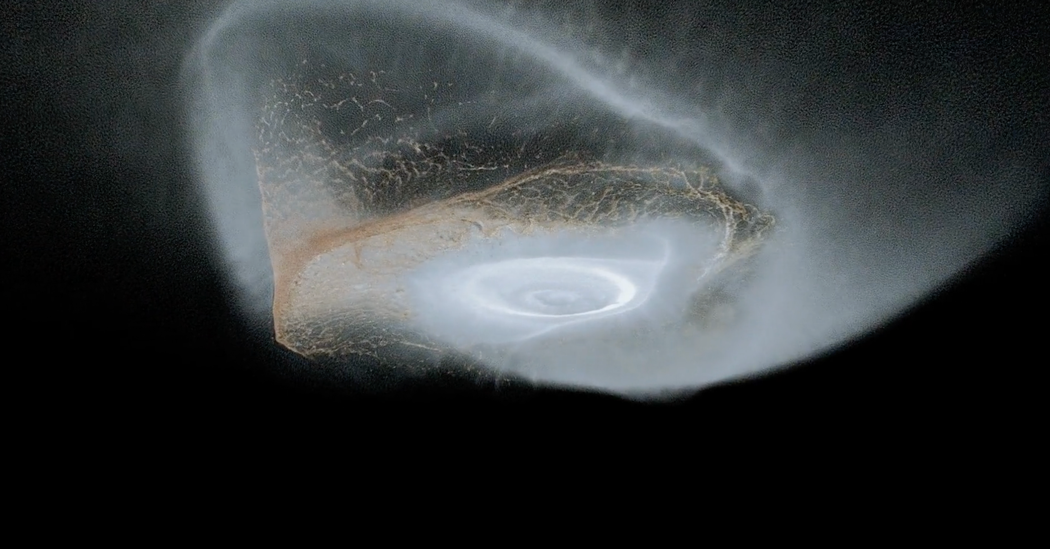Try to imagine Saturn without its signature rings. Now picture two large icy moons shifting closer together little by little until — boom. Chaos. What was solid is now fluid. Diamantine shards scatter into the darkness. Many icy fragments tumble close to Saturn, remain there and dance around the gas giant in unison, ultimately forging the heavyweight body’s exquisite discs.
This spectacular scene comes from an attempt to answer one of the greatest mysteries of the solar system: Where did Saturn’s rings come from, and when did they form?
A study, published this week in The Astrophysical Journal, leans into the notion that they are not billions of years old, but were crafted in the recent astronomic past—perhaps by the collision of two modestly sized frost-flecked moons only a few hundred million years ago.
“I’m sure it would have been great to see if the dinosaurs had had a good enough telescope,” Jacob Kegerreis, a research scientist at NASA’s Ames Research Center in Mountain View, Calif., and one of the study’s authors.
Dr. Kegerreis and his colleagues tested the younger-rings hypothesis using Britain’s Distributed Research Using Advanced Computing facility. This supercomputing system allowed the researchers to repeatedly recreate this cataclysm with greater detail along with its immediate aftermath, finding that this origin story is plausible.
The team’s simulations may aid scientists in studying not only the genesis of Saturn’s rings, but of all worlds. With its myriad satellites, Saturn “can be considered a mini-solar system,” said Scott Sheppard, an astronomer at the Carnegie Institution for Science in Washington, who was not involved with the new study. “Saturn is a perfect laboratory to understand how planets and moons form.”
Saturn, 4.5 billion years old, is almost as senior as the sun. Its rings were thought to be similarly ancient until the Cassini spacecraft studied the planet up close for 13 years. Across billions of years they should have been sullied by other dusty space debris. But the icy rings appeared too shiny and clean to be primeval.
This along with other evidence has convinced many scientists who study Saturn that the rings appeared a few hundred million years ago. If they didn’t emerge during the pandemonium of the early solar system when large objects routinely collided, that meant they formed in the relatively halcyon days of the recent astronomical past. But how?
Saturn now has at least 145 moons and probably possessed many before it developed rings. Scientists have argued that the immense gravity of the sun may have gradually destabilized some of the moons’ orbits, culminating in a two-moon collision.
The new study found that a strike between two icy satellites would blast plenty of frozen confetti toward Saturn. If that ice crossed and remained behind the Roche limit — a boundary beyond which a planet’s gravitational tides would disintegrate moons — then it would stand a chance at forming those rings.
Shards that remain behind the limit may have smashed into other satellites, splintering them and unleashing more material — the sort that could clump together to form newborn moons.
It isn’t clear which of the current moons are relatively adolescent. But Rhea, the second-largest moon of Saturn after Titan, may be an example. If it were older, it would have lived through various gravitational to-and-fros, and its orbit would be more eccentric. But instead Rhea is circular and flat, suggesting that it formed very recently — perhaps built out of that freshly released moon-making material.
Some of Saturn’s moons may have potentially habitable subsurface oceans. But if those moons are younger than believed, that possibility could be reduced.
“We still don’t know what the chances are of life evolving there,” Dr. Kegerreis said. But if some of these moons are younger than what scientists have thought, “that might cut down the chances of life being there.”
The longstanding debate over the provenance of Saturn’s halos won’t be settled by this study. But it emphasizes that the rings are ephemeral and ever-changing, rather than static decorations.
“Whether it’s Saturn or elsewhere, I think it’s fun how dramatic the solar system can be,” Dr. Kegerreis said.











